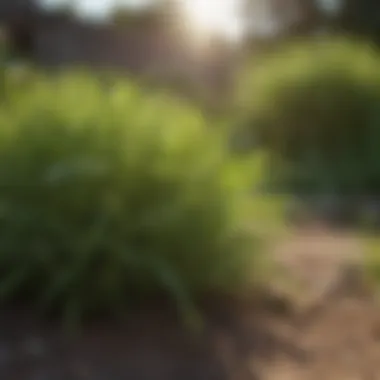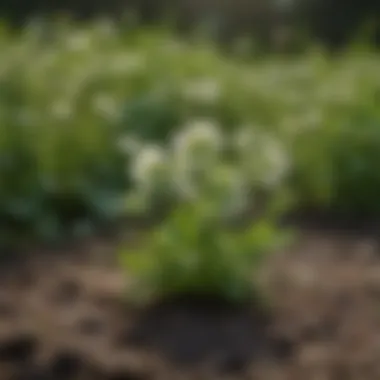Understanding Common Weeds in Your Yard


Intro
Weeds are often viewed as mere nuisances but understanding them is essential for effective garden management. They can flourish in diverse environments and are capable of thriving even in less-than-ideal conditions. Acknowledging the variety of weeds present in your yard is the first step towards managing them. This understanding will allow for better practices in gardening and landscaping.
In this guide, we will explore common weeds found in home gardens and yards. We will delve into their identification, understanding their ecological roles, and how they impact local ecosystems. We will also provide practical strategies for control and prevention. This comprehensive approach is designed for everyone from casual gardeners to professionals in agriculture and horticulture.
Identifying weeds isn't just about looking for unwanted plants. Each weed has its characteristics, including growth patterns, leaf shapes, and flowering seasons. By learning these traits, you will be better prepared to manage them effectively. This guide aims to enhance your knowledge of weeds and promote sustainable practices in maintaining healthy landscapes.
Beyond identification, weeds play important ecological roles. They can improve soil quality, provide habitat for various organisms, and affect the dynamics of the ecosystems in which they grow. Thus, understanding their roles helps you make informed decisions about management while recognizing their benefits.
This article will progressively widen the lens on the topic; from core concepts to practical applications, every aspect will be tackled thoughtfully. Let's begin our exploration into the world of common weeds that reside in your yard.
Preface to Common Weeds
Understanding common weeds is essential for anyone seeking to maintain a healthy yard or garden. These plants, often viewed as nuisances, can significantly impact the overall ecology of your landscape. Recognizing what constitutes a weed, their characteristics, and their effects on desired plants is fundamental for effective management.
Defining Weeds
A weed is any plant that grows in an undesired location, competing with cultivated plants for resources like water, nutrients, and sunlight. While many perceive weeds negatively, they hold ecological roles in their environments. Common examples include dandelions, crabgrass, and thistles. Understanding specific species can help assess their impact on your garden, making it easier to determine appropriate control methods.
Importance of Identifying Weeds
Identifying weeds is crucial for effective yard management. Distinguishing between beneficial plants and those that may hinder growth fosters informed decision-making.
Knowledge of weed types can help in:
- Resource Management: Weeds can outcompete desired plants for water and nutrients. Identifying them enables targeted interventions.
- Reducing Pest Risks: Certain weeds act as hosts for pests and diseases. Removing these can help protect your plants.
- Enhancing Aesthetics: An overgrown yard with weeds can look unkempt. Identification and removal can maintain the visual appeal of your landscape.
"Understanding the enemy is the first step towards effective control."
When you know your weeds, you can strategically manage them, leading to a healthier, more enjoyable yard.
Key Characteristics of Weeds
Understanding the key characteristics of weeds is fundamental to effective garden management. Weeds are not just nuisances; they possess specific traits that allow them to thrive in diverse environments. By recognizing these characteristics, gardeners can implement targeted strategies to control and manage them.
Growth Patterns
Weeds display distinct growth patterns that influence their spread and survival. Most commonly, weeds can be categorized into three growth habit types: upright, spreading, and rosette. Each has its own implications for garden management.
- Upright Weeds:
- Spreading Weeds:
- Rosette Weeds:
- These weeds grow vertically and can often grow taller than desired plants. Common examples include thistles and dandelions. Their height can shade or outcompete neighboring plants for light, stunting their growth.
- These weeds propagate through horizontal growth, expanding across the soil surface. Crabgrass is a pivotal example, thriving in disturbed areas and forming dense mats that smother desirable plants beneath.
- Characteristics of rosette weeds involve a low-growing cluster of leaves often close to the ground, typical in spring. Chickweed represents this category well. Their growth can inhibit other plants by blocking sunlight.
Understanding these growth patterns allows gardeners to make more informed decisions regarding their control efforts, ensuring more efficient management.
Reproductive Strategies
Weeds employ various reproductive strategies that greatly enhance their survival and dispersal. The efficiency with which these plants reproduce contributes significantly to their prevalence in yards and gardens.
- Seed Production:
- Vegetative Propagation:
- Hybridization:
- Most weeds are prolific seed producers. For instance, a single dandelion can generate thousands of seeds, facilitating easy dispersal by wind. This means that even a few individual plants can quickly lead to an infestation.
- Many perennial weeds can reproduce through underground stems or root systems. Bindweed is a prime example. It can regenerate new shoots from small segments of roots left in the soil, making eradication challenging without thorough efforts.
- Some weeds can hybridize with other species, creating new variants that may be more resilient to environmental stressors. This phenomenon complicates management practices as it can result in weeds that are more difficult to control.
Effective weed management requires awareness of these reproductive methods. Being prepared for how weeds reproduce can help in devising strategies that limit their ability to spread and dominate.
Understanding the growth patterns and reproductive strategies of weeds is essential for developing effective management practices. By recognizing these traits, gardeners can take proactive measures to control weed populations.
Common Types of Weeds
Understanding the different types of weeds is crucial for effective yard management. Each category exhibits unique characteristics that influence how they compete for resources within your garden. By familiarizing yourself with annual, perennial, and biennial weeds, you can develop targeted strategies for their control and prevention, thus enhancing the overall health of your landscape.
Annual Weeds


Annual weeds complete their life cycle within a single growing season. They germinate, grow, flower, and produce seeds all in a short period. Common examples include crabgrass and chickweed. One key feature of annual weeds is their rapid reproduction; they can deposit thousands of seeds in a single season. This quality makes them highly competitive, especially in disturbed areas or newly planted beds.
Management of annual weeds often involves mechanical and cultural controls.
- Regular mowing can prevent them from seeding.
- Mulching creates a barrier that suppresses their growth.
- Crop rotation disrupts their life cycles and limits their establishment.
Perennial Weeds
Perennial weeds, unlike their annual counterparts, persist for multiple growing seasons. They often have extensive root systems, enabling them to survive adverse conditions. Weeds such as dandelion and bindweed are notable examples. Their underground storage organs, such as rhizomes or tubers, allow them to regrow even if the above-ground parts are removed.
Controlling perennial weeds is more challenging due to their resilience.
- Consistent cutting can weaken their stamina.
- Targeted herbicide application may be necessary, but it requires careful timing and consideration.
- Additionally, implementing cultural practices, like maintaining healthy lawn care, can prevent their spread.
"Understanding the type of weed is the first step in effective yard management."
Biennial Weeds
Biennial weeds have a distinct life cycle spanning two years. In the first year, they typically produce foliage, while in the second year, they flower and set seeds. Weeds like mallow and wild carrot fall into this category. During their first year, they can be easily overlooked, but they can become more noticeable as they flower and spread seeds in their second year.
Effective management for biennial weeds includes:
- Early intervention during the first year.
- Removing flowering stems before seeds mature can limit their spread.
- In some cases, regularly disturbing the soil can prevent their establishment.
By comprehensively identifying these common types of weeds, you can tailor your management strategies to effectively control them. This focused approach not only preserves the aesthetics of your yard but also supports the overall ecosystem.
Identifying Common Weeds in Your Yard
Identifying common weeds in your yard is essential for effective lawn and garden management. Weeds can be a source of frustration for gardeners, as they often compete with plants for nutrients, water, and sunlight. Recognizing these unwelcome plants is the first step in control and prevention. By being knowledgeable about specific weed species, you can quickly assess the condition of your yard and make informed decisions about management strategies.
Proper identification promotes better decision-making. With the right information, you can choose between manual removal, chemical herbicides, or other control methods. By understanding the characteristics of each weed type, individuals can also prevent future growth and minimize their return. This understanding leads to healthier plants and a more attractive yard, fostering an environment where desired flora can thrive.
Dandelion
The dandelion, scientifically known as Taraxacum officinale, is a perennial weed recognizable by its bright yellow flowers and jagged leaves.
Identifying features: Dandelions have a rosette of deep green leaves surrounded by a stem that produces a single flower head. When the flowers die, they turn into round seed heads that disperse easily by wind. This plant thrives in a variety of conditions, making it particularly resilient and common in many yards.
Impact: Dandelions can compete effectively with grass for nutrients. However, they also attract beneficial pollinators, adding to the ecosystem's diversity. Managing this weed commonly involves manual removal or targeted herbicides.
Crabgrass
Crabgrass refers to several annual weeds, primarily Digitaria sanguinalis. This weed is notorious for its rapid growth and can smother desired grass varieties.
Identifying features: Crabgrass has broad, flat leaves that spread out on the soil surface, creating a dense mat. It typically germinates in warmer months and grows quickly, often reaching up to 2 feet in height. Its presence indicates poor lawn care, usually due to inadequate mowing or watering practices.
Impact: Crabgrass can reduce the aesthetic quality of a lawn and compete for resources, particularly during summer months. Management strategies include regular lawn care practices to discourage its growth and using pre-emergent herbicides during spring.
Chickweed
Chickweed consists primarily of Stellaria media, an annual that is particularly troublesome in cooler weather.
Identifying features: Known for its tiny white flowers and broad, succulent leaves, chickweed grows close to the ground. It often appears in early spring and remains prevalent until late autumn, thriving in moist, shaded spots.
Impact: Although it can serve as cover for beneficial insects, chickweed competes aggressively with young plants and can hinder their growth. Effective management involves keeping garden beds free of debris and applying mulch to suppress growth.
Bindweed
Bindweed, commonly referred to as Convolvulus arvensis, is a perennial weed that presents unique challenges due to its climbing nature.
Identifying features: Bindweed leaves are arrow-shaped, and the plant produces white or pink funnel-shaped flowers. It grows in a vine-like manner, wrapping around trees, shrubs, and other plants, often leading to significant damage.
Impact: This weed can be particularly destructive as it competes for light and space. Unlike other weeds, bindweed can establish deep roots, making it difficult to eradicate. Effective methods include thorough manual removal and targeted herbicide application with a focus on the roots.
Thistle
Thistle refers to several species, but Cirsium vulgare is most common in yards. It is a biennial plant that can cause considerable disruption if left unchecked.
Identifying features: Thistles have spiny stems and purple flower heads that emerge in the second year of growth, often towering above other nearby plants. They develop a rosette of leaves during the first growing season before reaching maturity.
Impact: Thistles are known for their aggressive growth and ability to produce numerous seeds. Their establishment can severely affect other plants, leading to reduced biodiversity. Regular maintenance and control methods, such as mowing before it seeds, can help manage its spread.
Proper identification and understanding of these common weeds can significantly enhance your ability to cultivate a healthy and beautiful yard. Recognizing these plants allows for informed management decisions, leading to an improved landscape.


Impact of Weeds on Yard Health
Weeds can significantly affect the overall health of a yard. Understanding the impact of these plants is crucial for maintaining a thriving landscape. Weeds are not just mere nuisances; their presence can indicate underlying health issues within the ecosystem of your garden. This section focuses on three major effects of weeds: competition for resources, their role as hosts for pests and diseases, and their impact on the aesthetics of your yard.
Competition for Resources
Weeds compete fiercely for essential resources such as sunlight, water, and nutrients. Many common weeds are aggressive growers, meaning that they can quickly take over spaces intended for desired plants. This competition can lead to decreased growth in flowers, vegetables, or grass. For instance, a dense patch of crabgrass can overshadow young seedlings, making them weak and stunted.
- Nutrient Depletion: Weeds can consume valuable nutrients from the soil, which affects the plants you want to thrive.
- Water Usage: They can use up moisture, leaving less available for other plants, especially in drier climates.
- Light Blockage: Tall or broad-leaved weeds can block sunlight, crucial for photosynthesis in garden plants.
This competition is not just about survival; it significantly alters the local ecosystem dynamics. Gardeners must proactively manage these invaders to minimize their effect on cultivated plants.
Pest and Disease Hosts
Weeds serve as reservoirs for pests and diseases. Certain species can harbor insects that attack nearby plants. For instance, bindweed can attract aphids, which then spread to tender crops. Additionally, some weeds can host pathogens that can easily jump to cultivated plants, leading to plant diseases.
- Insects: Weeds can provide shelter and food for pests that then travel to your crops or ornamentals.
- Pathogens: Many diseases can thrive within specific weed species, impacting plant health.
It's important to note that managing weeds can reduce pest populations and lower the risk of disease spread. Recognizing this correlation helps in planning effective integrated pest management strategies.
Aesthetic Considerations
In terms of aesthetics, weeds can dramatically alter the appearance of a yard. A well-maintained garden is often characterized by tidy arrangements of plants, flowers, and grass. The uncontrolled growth of weeds can turn a vibrant garden into a chaotic field of greenery. This not only impacts the visual appeal but can also lower property value and decrease overall satisfaction with the space.
- Visual Disruption: Weeds can overwhelm cultivated plants, leading to an unkempt look.
- Diversity of Plants: Some weeds may compete with desired flowering plants, reducing biodiversity and the intended design of the landscape.
Maintaining an attractive yard requires continuous diligence. Early identification and management of weeds can preserve both the beauty and ecological balance of your yard.
Weed Management Strategies
Effective weed management is a fundamental aspect of maintaining a healthy yard or garden. This section explores various strategies that can be employed to control weed growth effectively while also considering environmental sustainability. Proper management not only enhances the aesthetic appeal of outdoor spaces but also promotes the health of the ecosystem.
Weeds can compete with desired plants for water, light, and nutrients. Thus, managing them is crucial for ensuring that your plants thrive. Furthermore, understanding and implementing the appropriate strategies can prevent weeds from returning, allowing your garden to flourish.
Cultural Control Methods
Cultural control methods focus on altering the growing environment to make it less conducive to weed infestation. This is often the first line of defense in weed management because it is proactive rather than reactive.
Some effective cultural strategies include:
- Proper Plant Selection: Choose plants that are well-adapted to your local environment. These plants can outcompete weeds for resources.
- Crop Rotation: Change the type of plants grown in an area periodically. This disrupts the life cycles of weeds that may emerge in a given crop type.
- Soil Health Maintenance: Healthy soil supports strong plants that can compete with weeds. Practices such as composting and using cover crops can improve soil quality.
By employing cultural practices, you create an environment where desired plants can thrive, making it harder for weeds to establish.
Mechanical Control Techniques
Mechanical control involves the physical removal of weeds. It can be labor-intensive but is often very effective, especially for small infestations. Some common mechanical methods are:
- Weeding by Hand: Regularly hand-pulling weeds is a straightforward way to manage them, especially smaller varieties. Make sure to remove the entire root to prevent regrowth.
- Mowing: Regular mowing of grass can prevent weeds like dandelions from going to seed and spreading further.
- Tilling: Turning the soil can disrupt the root systems of weeds. However, this should be done carefully as it can also disturb the soil and create an opportunity for new weeds to grow.
While mechanical methods can be effective, they require consistent effort and commitment.
Chemical Control: Herbicides
Chemical control should be seen as a last resort when cultural and mechanical methods fail to provide adequate control. Herbicides can be effective in managing persistent weeds but must be used carefully to minimize environmental impact.
There are two main types of herbicides:
- Pre-emergent Herbicides: These prevent weed seeds from germinating. It is essential to apply them at the right time for them to be effective.
- Post-emergent Herbicides: These are used on existing weeds. It is crucial to read the label for correct application techniques and timing for optimal results.
Remember: Always follow the manufacturer's directions and consider non-chemical alternatives whenever possible to ensure sustainable practices.
Using herbicides can provide quick results, but they should be integrated with other methods for long-term effectiveness.
In summary, employing a mix of cultural, mechanical, and chemical strategies can result in effective weed management. Each method offers unique benefits and should be carefully evaluated depending on your specific gardening context.
Preventing Weed Growth
Preventing weed growth is a critical aspect of maintaining a healthy yard. Weeds can outcompete desirable plants for nutrients, water, and sunlight. They may also harbor pests and diseases which can spread to your main crops or garden plants. By focusing on prevention, you can reduce the need for reactive measures, which often involve extensive labor and resources.
Here, we will explore three key strategies for effective weed prevention.
Mulching Techniques


Mulching plays a significant role in weed control. By adding a layer of organic or inorganic material on the soil surface, you can limit the sunlight that reaches the soil. This will directly hinder the germination of weed seeds. Additionally, mulch helps retain soil moisture, benefiting your plants.
When choosing a mulch, consider the following:
- Organic Options: Wood chips, straw, and grass clippings decompose over time, enriching the soil.
- Inorganic Options: Landscape fabric or plastic mulch can provide a long-lasting barrier against weeds.
- Application Depth: Aim for a thickness of 2-4 inches. This depth is sufficient for effective weed suppression without harming your plants.
Proper Lawn Maintenance
Maintaining a healthy lawn is vital in preventing weed establishment. A lush, well cared lawn is less likely to allow weeds to thrive. Here are some maintenance tips:
- Regular Mowing: Keep your lawn at the recommended height for your specific grass type. Different grasses have different height requirements, but generally, a height of 2.5 to 3 inches is ideal.
- Fertilizing: Use slow-release fertilizers to ensure your lawn gets the nutrients it needs over time. This promotes strong growth, making it harder for weeds to take hold.
- Aeration: Aerate your lawn at least once a year, especially if the soil is compacted. This improves air flow and allows nutrients to penetrate the soil more effectively.
Crop Rotation and Companion Planting
Both crop rotation and companion planting can contribute significantly to weed control.
- Crop Rotation: Changing the type of crops you grow in a specific area each year prevents weeds from becoming established. Different crops require different resources, making it difficult for weeds to adapt.
- Companion Planting: Certain plant combinations can suppress weed growth. For instance, planting legumes can invigorate the soil while certain dense leafed plants can shade out weeds. Effective pairs include:
- Basil with tomatoes
- Carrots with onions
- Corn with beans
By implementing these strategies, you can minimize weed growth effectively. Regular attention and commitment to these practices can lead to a healthier garden and a more enjoyable gardening experience.
"Preventing weeds is often easier than trying to control them once they have taken hold."
The Role of Weeds in Ecosystems
Understanding the role of weeds in ecosystems is crucial for recognizing their impact beyond mere nuisances in gardens and yards. While they are often removed or eradicated, these plants can contribute significantly to biodiversity and soil health. This section will delve into two specific elements: their contributions to biodiversity and their role in improving soil health.
Biodiversity Contributions
Weeds play a significant role in promoting biodiversity within an ecosystem. They provide essential habitats for various insects, birds, and small mammals. In many cases, weeds serve as food sources for pollinators, such as bees and butterflies, which are vital for the continuation of many plant species. The presence of these weeds can attract a range of beneficial organisms, creating an interconnected web of life.
- Nutritional Resources: Weeds can yield nectar and pollen, fostering the survival of pollinator populations.
- Habitat Creation: Dense weed growth can create shelter for small animals, which can help maintain ecosystem balance.
- Seed Sources: Weeds often produce abundant seeds, which attract birds and other wildlife, supporting natural food chains.
By supporting various species, weeds contribute to a more robust ecosystem. They often thrive in disturbed areas, making them pioneers in ecological succession. Their presence can indicate soil health and help in the restoration of degraded landscapes, showing that they play a more complex role than commonly perceived.
Soil Health Improvement
Weeds are often dismissed as unwanted plants, yet they serve significant functions regarding soil health. Some key aspects of how they influence soil include:
- Soil Stabilization: The root systems of many weeds help bind soil particles together, reducing erosion and preventing nutrient loss.
- Nutrient Cycling: Certain weeds can improve soil nutrient availability by accumulating nutrients from deeper soil layers, making them accessible to other plants when they die off or are incorporated into the soil.
- Organic Matter Contribution: As they grow and die, weeds contribute to the organic matter in the soil, improving its structure and fertility.
"Weeds can often be a sign of a healthy and diverse ecosystem, provided that they do not overwhelm cultivated plants."
Best Practices for Sustainable Weed Management
Sustainable weed management is crucial for maintaining the health of yards and gardens. The emerging challenges posed by climate change, invasive species, and increasing pest resistance emphasize the need for effective strategies that minimize harm to the ecosystem. Implementing sustainable practices not only helps to control weed growth but also promotes soil health and biodiversity. It ensures that the landscape remains productive while reducing reliance on synthetic herbicides. The integration of environmentally friendly techniques establishes a balance between plant health and ecosystem integrity.
Integrative Methods
Integrative methods combine various techniques to manage weeds sustainably. These strategies can significantly decrease weed populations while enhancing plant health. Common integrative methods include:
- Cultural Practices: These involve altering crop management routines to discourage weed growth. Crop rotation, intercropping, or even altering planting times can limit the conditions that favor weeds.
- Physical Removal: Hand-pulling, hoeing, or using mulch can effectively reduce weed populations. This method is labor-intensive but, when combined with other techniques, it yields positive results.
- Educating Gardeners: Knowledge and awareness about local weed issues empower gardeners and farmers. Workshops and community outreach can enhance understanding of weed management strategies.
Integrating various methods not only controls weeds but also fosters a more resilient ecosystem.
Community Involvement
Community involvement plays a vital role in sustainable weed management. The collective effort of neighbors enhances the effectiveness of weed control measures. Initiatives such as community gardens or cooperative farming create environments where sustainable practices can be shared and improved. Key aspects of community involvement include:
- Shared Resources: Communities can pool resources for tools or expert consultations.
- Education Programs: Organizing workshops and information sessions to disseminate best practices benefits everyone.
- Networking Opportunities: Building connections between local gardeners and farmers encourages the exchange of knowledge about effective weed management techniques.
Fostering community engagement helps to create a united front against weeds, leading to more sustainable outcomes. Both integrative methods and community involvement establish a proactive approach to managing weeds, leading to healthier yards and gardens.
Closure
The conclusion serves as a pivotal part of the discourse on common weeds. It is not simply an ending but a vital synthesis that emphasizes the key insights shared throughout the article. Understanding weeds involves recognizing their threat, but also their ecological importance.
Summarizing Key Points
In reviewing the major themes of this guide, we can see that:
- Weeds are defined as unwanted plants that compete for resources in gardens and yards. Their identification is crucial for effective management.
- Key characteristics like growth patterns and reproductive strategies help in understanding how weeds proliferate. Knowing whether they are annual, perennial, or biennial affects management decisions.
- Common types of weeds such as Dandelion, Crabgrass, and Thistle were examined, highlighting their unique traits and methods of control.
- The impact of weeds on yard health was discussed. Weeds vie for resources, serve as hosts for pests and diseases, and can detract from the aesthetic value of gardens.
- Several weed management strategies were outlined. From cultural controls to chemical options, a myriad of methods exist, each with its own advantages and limitations.
- Prevention methods like mulching and proper lawn maintenance were emphasized to reduce future weed growth.
- Finally, we explored the role of weeds in ecosystems and the necessity of integrating sustainable practices into weed management. This includes community involvement and ecological balance.
Future Considerations in Weed Management
As we look forward, it becomes increasingly vital to develop adaptive practices in weed management. Technological advances and ongoing research into sustainable agriculture may yield new insights. Considerations for the future include:
- Emphasizing biodiversity: Encouraging diverse plant life can help compete against weeds naturally and improve soil health.
- Sustainable practices: Innovations in organic herbicides and natural pest management are likely to grow. This promotes not only yard health but also environmental safety.
- Community education: Increasing awareness through workshops and sharing experiences can lead to more effective management strategies.
- Monitoring environmental impact: Research continues into the ecological effects of herbicides and pesticides, guiding future legislative actions.















